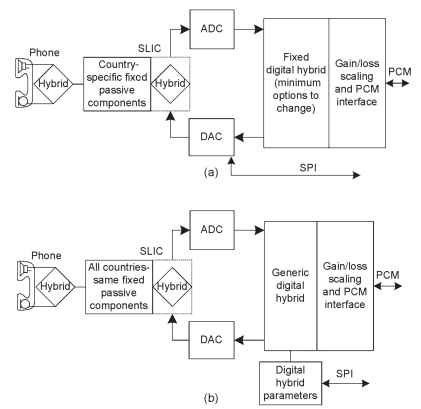17.2
The VoIP adapter is a CO to the telephone user connected at an FXS interface of a VoIP box. The VoIP adapter has to emulate the characteristics of a PSTN CO. The front-end SLIC of a VoIP adapter is programmed for required voltages, line conditions, REN drive, impedances, gain/loss, and diagnostic features. Some parameters of call progress tones, DTMF, and call feature generation are programmed through a processor attached to the SLIC and CODEC. Many of these parameters are country-dependent variations that have to be taken care of in the VoIP adapter, and these features and parameters run into several pages in local PSTN standards.
17.2.1
Telephone Impedance Programmed on the VoIP Adapter
As represented in Fig. 17.2 , the alternating current (AC) terminating impedance can be modeled through resistors and a capacitor as an Rs, (Rs + Cs) or Rs + (Rp \\ Cs) that takes care of multiple countries. The values vary for different countries. As an example, France has 270Q + (750£2 II 150nF), France (TBR21) is 275 Q + (780Q II 115nF), and the United States/Korea/Japan uses 600 Q, or 600 Q + l^Fas an equivalent telephone impedance. More country-specific details are available at references [URL (Cisco - impedance) , URL (Silab-DAA), URL (Si3015), URL (WinSLAC), URL (Microtronix-470C)]. Refer to the country-specific standards for the exact and complete information, as some discrepancy exists among the published literature on this subject.

Figure 17.2. Equivalent impedance representation of telephone. (a) Complex impedance in series with parallel RP CS. (b) Complex impedance of RS in series with CS. (c) Real Impedance Rs.
The convention of representing numerical values of Ra Rp, and Cs varies in the literature and in other documents. As an example, when Rp is not present, it will be left as blank, or the symbol for infinity (°°, meaning open or not present). Refer to the description in the standards for exact details on these component values. The values of Rs, Rp, and Cs varies with the country. For reference, a few examples are given in this section.
17.2.2
Hybrid Matching for Multiple Countries
VoIP adapters drive telephones through the FXS interface. The FXS interface is built with SLIC-CODEC functionality devices. Historically, SLICs were made with several passive components, battery, and ring combining circuits. Recently, most SLICs are of active circuits. For each country, these devices may use different extra passive components. The goal is to match telephone and the SLIC-CODEC interface hybrid to get better echo return loss (ERL). In the case of the PSTN, central office impedance in combination with lines and telephone are approximately matched. Proper impedance matching also helps in reducing echo level in the PSTN and VoIP.
Recent designs have taken care of hybrid implementation in two stages. The first stage is of a fixed hybrid implemented with a fixed combination of components as part of the SLIC. This stage is shown in Fig. 17.3(a). The SLIC manufacturers will decide the required fixed hybrid passive components. The

Figure 17.3. Impedance combinations. (a) Fixed impedance hardware software scheme. (b) Country selection through fixed passive components and digital hybrid parameters.
mismatched signal after passing through a fixed analog hybrid of a SLIC is sampled in hardware CODEC—[analog-to-digital converter (ADC) and digital-to-analog converter (DAC)]. These digital samples are used to form a digital hybrid. Digital hybrids are implemented as filter networks and as amplitude summing operations. These coefficients are fixed in nature for the populated passive components and country requirements. This scheme also calls for changing passive components for different country impedance combinations. Several aspects of impedance matching and measurements are given in references [URL (Seemix), URL (Microtronix-501), URL (Elect-matching), URL (Cisco - impedance) ].
A country-specific programmable scheme is shown in Fig. 17.3(b). In this scheme, a SLIC will have a fixed set of analog components that are valid for multiple country requirements. The perfect hybrid functions are achieved as a combination of a fixed analog hybrid and a variable digital hybrid. Depending on the country, software will send different coefficients into a digital hybrid that makes an analog hybrid and an updated digital hybrid into the perfect
combination. This process will occur usually through serial peripheral interface (SPI) communication used to interface with SLIC-CODEC devices. The generic way is to send required coefficients depending on the country and the populated passive components with a SLIC analog hybrid. In some devices like Si3015 [URL (Si3015)], the required coefficients are programmed in the CODEC device. A digital hybrid will use one of the available sets of coefficients to meet multiple country requirements. Such a country impedance selection table can be found at reference [URL (Si3015)]. Currently, this type of digital hybrid with fixed passive components (meaning a fixed analog hybrid), with a programmable digital hybrid, is most popular for taking care of multiple countries.
As an advanced option, these hybrids can be made adaptive. Even after making the country selection, hybrids can be mismatched based on phones connected or parallel phones used on the same interface. For this reason, a combination of adaptive and or country-specific selection can be used. From the ADC, DAC digital signals, a hybrid path can be calculated, which can help in deriving the correct coefficients. This path will work as an echo canceller with coarse estimation. After estimation of the coefficients, the values can be held fixed for that call. In most situations, the coefficients can be changed only on a new call. In practice, VoIP solutions use high-performance echo cancellers that are more powerful in taking care of any variation that may happen with different or multiple phones.
